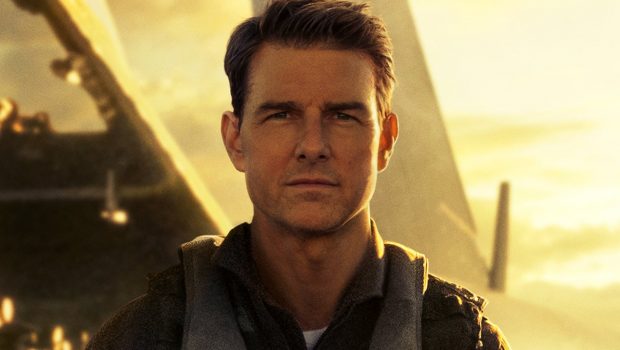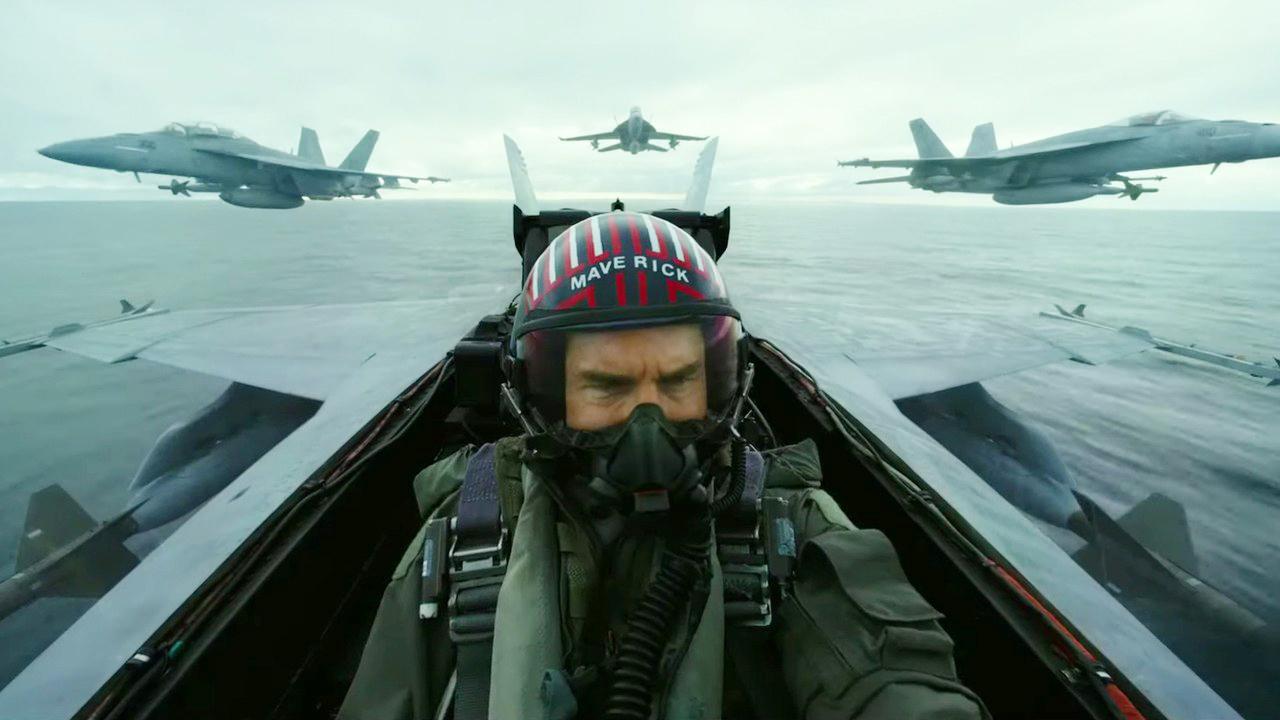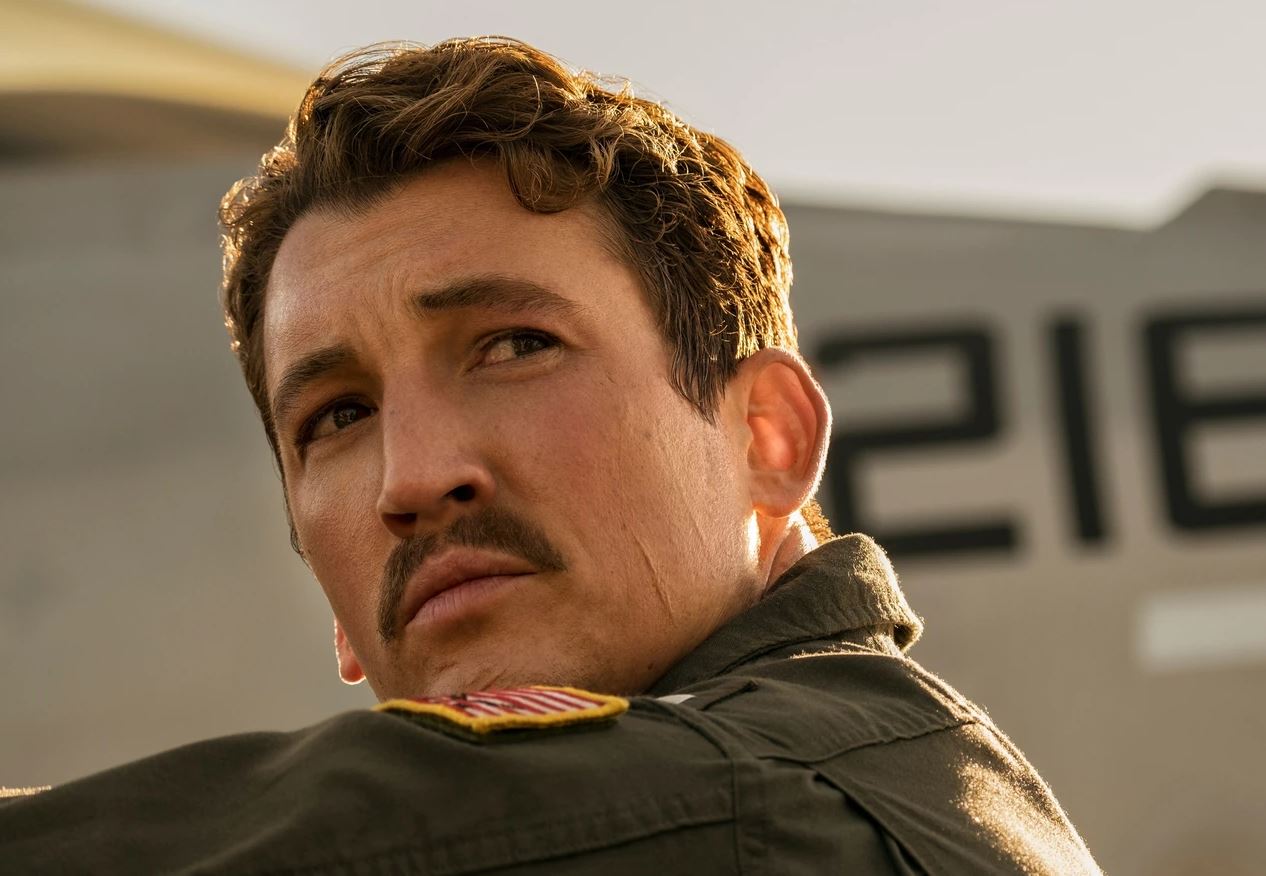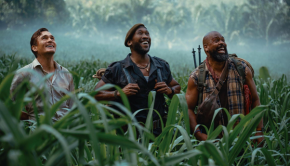Top Gun: Maverick – Film Review
Reviewed by Damien Straker on the 19th of June 2022
Paramount Pictures presents a film by Joseph Kosinski
Screenplay by Ehren Kruger, Eric Warren Singer, and Christopher McQuarrie
Produced by Jerry Bruckheimer, Tom Cruise, Christopher McQuarrie, and David Ellison
Starring Tom Cruise, Miles Teller, Jennifer Connelly, Monica Barbaro, Jon Hamm, Glen Powell, Lewis Pullman, Ed Harris, and Val Kilmer
Cinematography Claudio Miranda
Edited by Eddie Hamilton
Music by Harold Faltermeyer, Lady Gaga, Hans Zimmer, and Lorne Balfe
Running Time: 131 minutes
Rating: M
Release Date: the 26th of May 2022
Top Gun: Maverick is a mature blockbuster and an improvement over its predecessor. It is a strong feat but the original film, directed by the late Tony Scott, is frankly a dinosaur. Made in 1986 when Tom Cruise was only twenty-four, it was a slick but dumb piece of Cold War propaganda. The prequel was also marred by excessive jingoism, eye-opening sexism, and worst of all, a weak screenplay. Watching it today only amplifies its flaws. It would have faded into the past if it were not for its financial dominance. From its meagre $15m budget it took a return of $350m. Until now a sequel seemed impossible. Cruise previously stated he would not make a sequel because of how Top Gun represented war. Filmmaker Oliver Stone also thought it was a fascist work. Maverick resolves some of these problems while leaving one or two untouched. Regardless, it enriches its hero in unexpected and surprisingly poignant ways. It is well engineered and offers having a reflective lens, which was largely unexpected from the belated sequel.
The narrative focuses again on rogue US Navy test pilot Peter ‘Maverick’ Mitchell (Cruise). His superiors, including ‘Hammer’ (Ed Harris), argue his rank has remained stagnant when he could have ascended or moved into politics. While Maverick insists this is where he belongs, he is soon recalled to the United States Navy Strike Fighter Tactics Instructor program, better known as ‘TOPGUN’. Admiral ‘Cyclone’ Simpson (Jon Hamm), a real jerk, is weary of Maverick’s reckless history but needs him to train a group of young elite aviators. Their mission is to destroy a dangerous uranium plant. There are only a few weeks to educate the recruits on how to successfully navigate through the mission’s dangerous terrain. The new pilots are codenamed ‘Hangman’ (Glen Powell), ‘Bob’ (Lewis Pullman), and ‘Phoenix’ (Monica Barbaro). Yet Maverick is most concerned about the arrival of Rooster (Miles Teller). Rooster is the son of Goose, Maverick’s best friend who died in a training accident. Maverick delayed Rooster’s papers for four years to deter him from Top Gun, which leaves bad blood between them. To ease his guilt, Maverick romances Penny (Jennifer Connolly) who owns a bar in California.
Maverick marks an efficient and skilful directorial effort from filmmaker Joseph Kosinski. He previously made two uneven sci-fi films, Tron: Legacy (2010) and Oblivion (2013), and the well-received firefighter movie, Only the Brave (2017). While Oblivion was a bland vehicle for Tom Cruise, this reunion sees Kosinski hone his craft. One area where Maverick excels is its pacing. Kosinski starts the film slowly by including enough character-building scenes to ensure it reaches a strong climax. Consequently, the last quarter’s action scenes are exciting and justified by establishing the relationships between the characters. Kosinski’s control over the action is exemplary, resulting in coherent, sweat-inducing action sequences involving aerial combat. The tension is amplified by a deft mixture of practical stunts, where the real Navy flew the actors around as they were filmed, and heavily disguised CGI shots. The dogfights involve Maverick’s crew evading enemy planes, releasing emergency flares, pulling through narrow spaces, and precariously rising to evade the face of a mountain. Most scenarios are kept grounded without veering too far into absurd combat. Though like the original, it begs to ask how these faceless enemy fighters are shot down without launching a complete declaration of war against the US. Take it all with a large handful of salt.
The confident scripting is courtesy of three writers, including Eric Warren Singer (American Hustle, 2013). The biggest improvement is the how the mission is properly filtered throughout the entire story. The original featured a laughable final twenty minutes where the villains attacked as the pilots graduated. Here the mission is outlined from the start and strengthened by visual cues dictating what the pilots must achieve. Various graphics and animations of the valley are displayed, which reduces excessive military jargon and exposition. As for right‑wing jingoism and recruitment, the story is more balanced. The film did receive equipment and technical support from the US Department of Defense and Lockheed Martin. However, it also resists painting the Navy’s uptight bureaucrats in a positive light. Flying planes and launching bombs looks exciting but remains dangerous given jerks like Cyclone fail to guarantee the young pilots will return home alive.
The screenplay is also buoyed by exploring a clear thematic goal, namely Maverick’s guilt. Much to the chagrin of his superiors, Maverick remains an enormous risk-taker. Yet the character possesses a deeper interior that replaces his unlikeable smugness. He remains affected and scarred by the death of Goose. The feeling of loss permeates throughout the training scenes. He resists including Rooster on the mission because of the past, a vow reinforced by a promise made to Rooster’s late mother that he would stop him flying. The psychology crafts a simple but interesting dynamic between the crew. Maverick talks a big game about discarding manuals and trusting your instincts while remaining cautious with age. Will he trust Rooster during the perilous combat mission? There are a few other clever ideas apparent in the screenplay. One is a discussion about automation, specifically the pilot programme being replaced by drone strikes. Meanwhile, there is metacommentary about Cruise himself when ‘Hammer’ tells Maverick: ‘your kind are headed for distinction’. Cruise’s stunt work is a gentle reminder that old-fashioned movie stars remain relevant, an idea strengthened by Maverick’s huge box office return.
Kosinski’s only missteps include overstating some of the nostalgia and spreading parts of the film too thin. Between the new crew, the call‑back scenes, the training, and a superfluous but disarming romance, it might have been more rounded with one less story element. For example, there is a long scene where Rooster plays ‘Great Balls of Fire’ on the piano and everyone sings along in the bar. It is obviously a throwback to a key scene from the original. Rather than letting the memory of the past gently seep through Kosinski cuts to a few snippets of Goose. Meanwhile, Maverick’s crew could have used richer characterisations. ‘Phoenix’, ‘Bob’, and ‘Hangman’ are basically stereotypes: the sensible woman, the soft geek, and the arrogant but redemptive jerk. It is also hard not to consider how a far more charismatic actor than Miles Teller would have painted Rooster besides his bitterness. Nonetheless, it is impossible to discard Cruise’s stoic portrayal. He also surprises by displaying a few moments of rare emotion and vulnerability. This is most apparent in Maverick’s best scene. It features a very poignant Val Kilmer cameo. In the original, his character ‘Iceman’ was constantly at odds with Maverick before they bonded. The reunion encompasses the film’s strongpoints: mature writing, a touch of nostalgia, and a sharp reflection on the difficulty of letting go.
Solid writing and fine craftsmanship make Maverick an engaging, above average blockbuster. The film is buoyed by exploring greater emotional depths than many other popcorn features. It applies its emotional current to the action scenes too. While not a dense character study we come to understand the protagonist’s moral dilemma. How do you remain instinctive while also protecting people you care about? It is arguably something Tom Cruise himself might have considered when performing his own dangerous stunts. The story is also a reflection on how grief permeates through two different generations. The psychology is visualised through exciting, intensely realised action scenes. If the rest of Maverick’s crew were as well-rounded it would be a complete knock-out. Regardless, the emotional weight works to ensure this a compelling action vehicle. There is speed to burn but more heart and mind than its predecessor.
Summary: Top Gun: Maverick is a mature blockbuster and an improvement over its predecessor.









